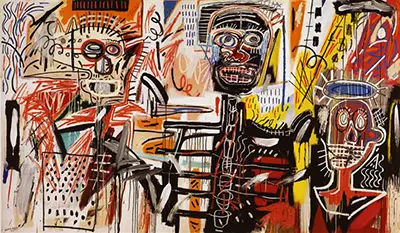We find three main figures in front of us here, each of them delivered in a chaotic frenzy of colour and form. Abstraction derives from Africa in this example, having been used many centuries before Europeans would start to implement it into western art during the early 20th century. One can recall the many African masks which mesmerised the likes of Gauguin and Picasso, and the style is similar to that used by Basquiat here. The background is also particularly busy too, meaning there is no let-up in the content displayed throughout this artwork. Colours here are varied, but always bold. Reds, oranges, yellows contrast with the lines of black, with some more solid areas also in black and white to help the brighter tones really take centrestage.
American art has established itself at the forefront of the international scene in the present era and much of this was down to the achievements of artists such as Basquiat during the second half of the 20th century, plus a number of other Abstract Expressionists. It was then that New York, in particular, would become the international melting pot for the exchange of different ideas and innovations. The likes of Paris, London and Rome would look on in admiration, eager to understand where the future direction would head. Smaller galleries in the cities would then adapt their own collections in order to move with the changing fashions as early as possible. This continues to occur today, and much of the legacy achieved by the Abstract Expressionists is still very much a part of the international industry, though new changes are sure to come across again soon in this ever moving marketplace.
The art world today embraces and welcomes the work of Basquiat into its homes, but it would take quite some time for the likes of Cabeza, Per Capita and Liberty to be fully accepted into the mainstream. Basquiat was a maverick and required a strong personality in order to keep fighting for what he believed in. Eventually, the quality of his work would be better understood and he would make that important transition from small galleries to larger exhibitions. It is a similar evolution that most creatives desire, including musicians as they start to perform in front of larger audiences. That said, he would still not get to see the truly extraordinary prices that are now attached to his work some decades later, as more and more collectors attempt to own something from the career of a highly influential and unique artist that helped comment on the changing times of American society within the 1970s and 1980s.


